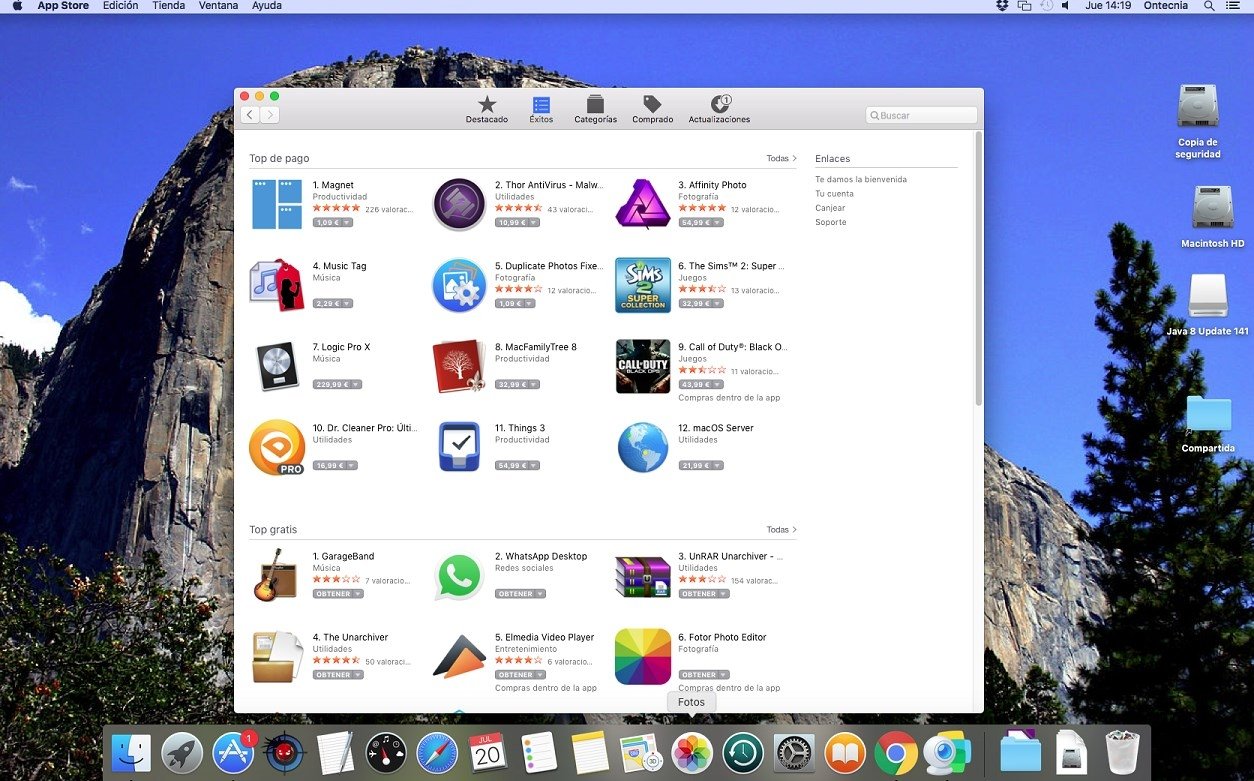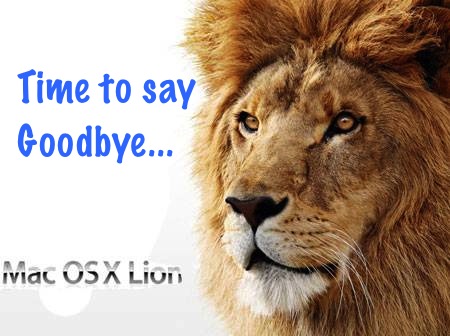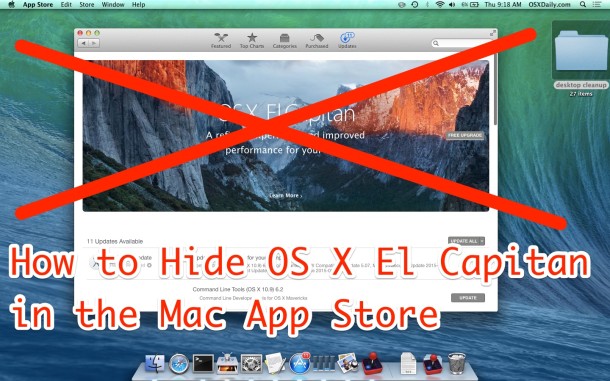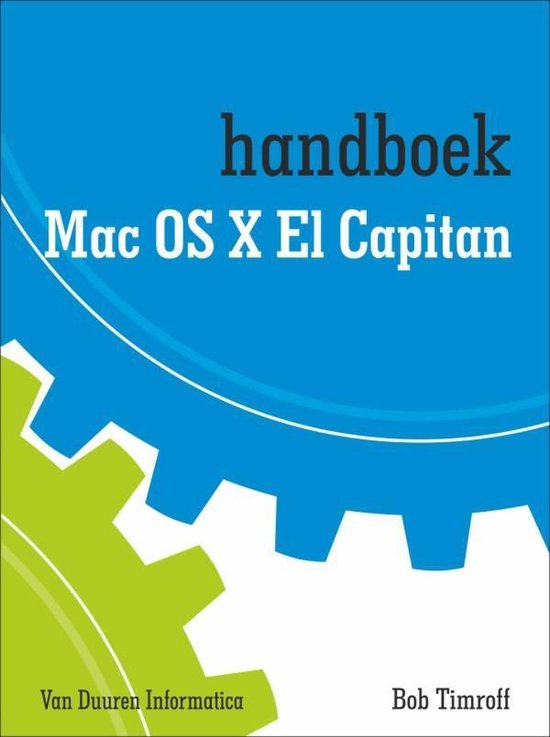Dec 22, 2020 Installing Mac OS X El Capitan. The installation process of mac os el Capitan includes two methods. The first method is termed as an upgrade install, also known as the default method. The second method is known as a clean install. Upgrade install-Follow to below steps-Visit the Mac App Store. Locate the OS X El Capitan Page. Click the Download. For the first time since Apple released OS X 10.8 Mountain Lion in July 2012, Apple has dropped support for a number of older Macs that had supported OS X 10.8 through 10.11 El Capitan. No MacBook and iMac models prior to Late 2009 and no MacBook Air, MacBook Pro, Mac mini, and Mac Pro models prior. Mac Os X Lion Update To El Capitan Can I Update My Mac From Lion To El Capitan Mac OS X Snow Leopard (version 10.6) is the seventh major release of macOS, Apple's desktop and server operating system for Macintosh computers. (Platform) OS X El Capitan (version 10.11) is the upcoming twelfth major release of OS X, Apple Inc.' S desktop and server operating system for Macintosh computers. It is the successor of OS X Yosemite and focuses mainly on performance, stability and security. It will be available as a free update.
For the first time since Apple released OS X 10.8 Mountain Lion in July 2012, Apple has dropped support for a number of older Macs that had supported OS X 10.8 through 10.11 El Capitan. No MacBook and iMac models prior to Late 2009 and no MacBook Air, MacBook Pro, Mac mini, and Mac Pro models prior. OS X El Capitan (10.11) on Unsupported Macs macOS Extractor and MacPostFactor are apps that guide you through patching and installing OS X El Capitan (10.11), Yosemite (10.10), Mavericks (10.9), or Mountain Lion (10.8) on your older Mac. Whilst it does lessen security somewhat, it is not the end of the world, and OS versions prior to El Capitan do not include it anyway. Related tutorial: How to disable System Integrity Protection 7) Once everything is ready, launch the macOS Sierra Patcher application. Question: I read somewhere that it is possible to install the latest version of OSX 10.10 Yosemite on my Mac, even though the official installer refuses to install. Can you give me any directions? Answer: Installing newer versions of OSX on slightly older Macs that do not meet the official system requirements. I am currently researching installing OS X 10.13 High Sierra on unsupported Macs. I did the Sierra upgrade on a couple of MacPros 4,1 and it has worked excellently, after I did a firmware update patch to get it to read as a MacPro 5,1, so I am very optimistic on doing it again.
For the first time since Apple released OS X 10.8 Mountain Lion in July 2012, Apple has dropped support for a number of older Macs that had supported OS X 10.8 through 10.11 El Capitan. No MacBook and iMac models prior to Late 2009 and no MacBook Air, MacBook Pro, Mac mini, and Mac Pro models prior to 2010 are officially supported by macOS Sierra, although workarounds have been developed for most unsupported 2008 and 2009 Macs.
Mac OS X is no longer being called OS X, and Apple is not promoting Sierra with a version number either (however, it is internally identified as OS X 10.12). Now it’s simply macOS Sierra – in keeping with iOS, tvOS, and watchOS.
macOS Sierra was released on Sept. 20, 2016 and officially requires a supported Mac with at least 2 GB of system memory and 8.8 GB of available storage space. (We recommend at least 4 GB of RAM.)
Officially Supported Macs
All Late 2009 and later MacBook and iMac models are supported in macOS Sierra, as are all 2010 and newer MacBook Air, MacBook Pro, Mac mini, and Mac Pro computers.
Hacking macOS Sierra for Unsupported Macs
Hardware requirements for macOS Sierre include a CPU with SSE4.1, so it cannot be run on any Mac with a CPU prior to the Penryn Core 2 Duo. In theory, it should be possible to get Sierra running on any Penryn or later Mac. It may be possible to swap out the Merom CPU in some Macs for a Penryn, which would then allow Sierra to run.
Sierra can run with 4 GB of system memory, but as with all recent versions of OS X, more memory will allow it to run even better.

Colin Mistr has published a macOS Sierra Patch Tool, which currently allows you to install and run macOS Sierra on the following officially unsupported hardware:
- Early 2008 iMac or later
- Mid 2009 MacBook (white) or later
- Late 2008 MacBook Air or later
- Early 2008 MacBook Pro or later
- Late 2009 Mac mini or later
- Early 2008 Mac Pro or later

Note: If you have the Early 2009 Mac Pro and have installed the firmware update patch so it identifies itself as MacPro5,1, you can run the standard installer. You do not need the patch tool.
You will need a USB drive 8 GB or larger and Mistr’s patch tool, which is linked on his page. WiFi does not function on these unsupported systems if they have the Broadcom BCM4321 WiFi module:
- Late 2008 and Mid 2009 MacBook Air
- Early 2008 and Mid 2008 MacBook Pro
New Features
Siri comes to the Mac with macOS Sierra.
macOS Sierra can automatically sync all files on your Desktop and in your Documents folder with other Macs running Sierra. You can also access these files in your iPhone or iPad using iCloud Drive.
Mac Os X El Capitan Dmg
The new Universal Clipboard lets you copy on one device and paste on another – whether it’s a Mac with Sierra or an iPhone or iPad with iOS 10.
Tabs are almost everywhere in Sierra, and they work much as they do in your browser. Third party apps will also be able to use tabs.
Apple Pay is now part of macOS, not just iOS.
Young mother 2 english subtitle. If you have an Apple Watch, Auto Unlock will authenticate you and log you in automatically when you approach your Mac.
Mac Os El Capitan Patcher Tool For Unsupported Mac Store
Optimized Storage can store infrequently used files in iCloud while keeping them immediately available any time you are online.
Availability
Apple developers can download an early pre-release version of macOS Sierra today, and a beta version will be available to users in July. The full release is scheduled for Fall 2016.
Keywords: #macossierra
Mac Os El Capitan Patcher
Short link: http://goo.gl/MkIekT
Microsoft lifecam hd 3000 driver. searchword: macossierra
Apple's OS X El Capitan in October got off to the fastest-ever one-month start for a Mac operating system.
El Capitan, also tagged by Apple as OS X 10.11, was released on the last day of September: 31 days later it had been installed on another 25% of all Macs, bumping its total to 27%, according to U.S. analytics firm Net Applications.
The October increase was the largest one-month user share gain by an edition of OS X in the six years that Computerworld has recorded Net Applications' data, beating Mavericks and Yosemite, the two previous upgrades Apple handed out free of charge.
Net Applications estimates operating system shares by tallying unique visitors to its clients' websites. In the absence of definitive data from Apple, user share is one of the few proxies for real-world OS X adoption.
When the release dates of each edition were taken into account, however, El Capitan's average daily adoption rate only edged Yosemite's and turned out to be lower than Mavericks'. Those forerunners launched in the second half of October in 2014 and 2013, respectively, and so spread their biggest gains over a longer stretch than El Capitan: 41 days for Mavericks and 47 days for Yosemite.
Not surprisingly, the majority of those who migrated to El Capitan came from its immediate predecessor, Yosemite. Last month, Yosemite shed more than a third of its user share as its users upgraded.
But other, even older versions of OS X also lost user share last month. Each of those tracked by Computerworld -- from 2007's Leopard on -- fell at rates larger than their average decline over the previous 12 months. Mavericks, for instance, fell to 14% of all editions of OS X, a two-point slide that was double its earlier average.
Mac Os El Capitan Patcher Tool For Unsupported Macs
Approximately 90% of all Macs were eligible to upgrade to El Capitan when the operating system launched on Sept. 30. El Capitan will run on the same Macs that have run Yosemite, Mavericks, 2012's Mountain Lion and 2011's Lion.
El Capitan Os X Download
On the flip side, a sizable number of Macs continued to run outdated editions of OS X last month. By Net Applications' data, about 16%, representing one in six Macs, was powered by a version that Apple no longer supports with security updates. Apple distributed the final security update for the three-year-old Mountain Lion in August. It continues to patch Mavericks and Yosemite, however.
The one-in-six who run unsupported operating systems seems to be the natural order. Not only has that same percentage of OS X users been on the retired list in earlier years -- even as new editions rolled out annually -- but in the Windows world, a double-digit fraction still run Windows XP, which left support more than a year and a half ago.
The free El Capitan upgrade can be obtained from Apple's Mac App Store, and supports iMacs as old as mid-2007, MacBook Pro notebooks from late 2007 on, and MacBook Air laptops from late 2008 going forward.

So, you’ve decided to download an older version of Mac OS X. There are many reasons that could point you to this radical decision. To begin with, some of your apps may not be working properly (or simply crash) on newer operating systems. Also, you may have noticed your Mac’s performance went down right after the last update. Finally, if you want to run a parallel copy of Mac OS X on a virtual machine, you too will need a working installation file of an older Mac OS X. Further down we’ll explain where to get one and what problems you may face down the road.
A list of all Mac OS X versions
We’ll be repeatedly referring to these Apple OS versions below, so it’s good to know the basic macOS timeline.
| Cheetah 10.0 | Puma 10.1 | Jaguar 10.2 |
| Panther 10.3 | Tiger 10.4 | Leopard 10.5 |
| Snow Leopard 10.6 | Lion 10.7 | Mountain Lion 10.8 |
| Mavericks 10.9 | Yosemite 10.10 | El Capitan 10.11 |
| Sierra 10.12 | High Sierra 10.13 | Mojave 10.14 |
| Catalina 10.15 |
STEP 1. Prepare your Mac for installation
Given your Mac isn’t new and is filled with data, you will probably need enough free space on your Mac. This includes not just space for the OS itself but also space for other applications and your user data. One more argument is that the free space on your disk translates into virtual memory so your apps have “fuel” to operate on. The chart below tells you how much free space is needed.
Note, that it is recommended that you install OS on a clean drive. Next, you will need enough disk space available, for example, to create Recovery Partition. Here are some ideas to free up space on your drive:
- Uninstall large unused apps
- Empty Trash Bin and Downloads
- Locate the biggest files on your computer:
Go to Finder > All My Files > Arrange by size
Then you can move your space hoggers onto an external drive or a cloud storage.
If you aren’t comfortable with cleaning the Mac manually, there are some nice automatic “room cleaners”. Our favorite is CleanMyMac as it’s most simple to use of all. It deletes system junk, old broken apps, and the rest of hidden junk on your drive.
Download CleanMyMac for OS 10.4 - 10.8 (free version)
Download CleanMyMac for OS 10.9 (free version)
Download CleanMyMac for OS 10.10 - 10.14 (free version)
STEP 2. Get a copy of Mac OS X download
Normally, it is assumed that updating OS is a one-way road. That’s why going back to a past Apple OS version is problematic. The main challenge is to download the OS installation file itself, because your Mac may already be running a newer version. If you succeed in downloading the OS installation, your next step is to create a bootable USB or DVD and then reinstall the OS on your computer.
How to download older Mac OS X versions via the App Store
If you once had purchased an old version of Mac OS X from the App Store, open it and go to the Purchased tab. There you’ll find all the installers you can download. However, it doesn’t always work that way. The purchased section lists only those operating systems that you had downloaded in the past. But here is the path to check it:
- Click the App Store icon.
- Click Purchases in the top menu.
- Scroll down to find the preferred OS X version.
- Click Download.
This method allows you to download Mavericks and Yosemite by logging with your Apple ID — only if you previously downloaded them from the Mac App Store.
Without App Store: Download Mac OS version as Apple Developer
If you are signed with an Apple Developer account, you can get access to products that are no longer listed on the App Store. If you desperately need a lower OS X version build, consider creating a new Developer account among other options. The membership cost is $99/year and provides a bunch of perks unavailable to ordinary users.
Nevertheless, keep in mind that if you visit developer.apple.com/downloads, you can only find 10.3-10.6 OS X operating systems there. Newer versions are not available because starting Mac OS X Snow Leopard 10.7, the App Store has become the only source of updating Apple OS versions.
Purchase an older version of Mac operating system
You can purchase a boxed or email version of past Mac OS X directly from Apple. Both will cost you around $20. For the reason of being rather antiquated, Snow Leopard and earlier Apple versions can only be installed from DVD.
Buy a boxed edition of Snow Leopard 10.6
Get an email copy of Lion 10.7
Get an email copy of Mountain Lion 10.8
The email edition comes with a special download code you can use for the Mac App Store. Note, that to install the Lion or Mountain Lion, your Mac needs to be running Snow Leopard so you can install the newer OS on top of it.
How to get macOS El Capitan download
If you are wondering if you can run El Capitan on an older Mac, rejoice as it’s possible too. But before your Mac can run El Capitan it has to be updated to OS X 10.6.8. So, here are main steps you should take:
1. Install Snow Leopard from install DVD.
2. Update to 10.6.8 using Software Update.
3. Download El Capitan here.
“I can’t download an old version of Mac OS X”
If you have a newer Mac, there is no physical option to install Mac OS versions older than your current Mac model. For instance, if your MacBook was released in 2014, don’t expect it to run any OS released prior of that time, because older Apple OS versions simply do not include hardware drivers for your Mac.
But as it often happens, workarounds are possible. There is still a chance to download the installation file if you have an access to a Mac (or virtual machine) running that operating system. For example, to get an installer for Lion, you may ask a friend who has Lion-operated Mac or, once again, set up a virtual machine running Lion. Then you will need to prepare an external drive to download the installation file using OS X Utilities.
After you’ve completed the download, the installer should launch automatically, but you can click Cancel and copy the file you need. Below is the detailed instruction how to do it. How to install sun explorer in solaris 11 commands.
STEP 3. Install older OS X onto an external drive

The following method allows you to download Mac OS X Lion, Mountain Lion, and Mavericks.
- Start your Mac holding down Command + R.
- Prepare a clean external drive (at least 10 GB of storage).
- Within OS X Utilities, choose Reinstall OS X.
- Select external drive as a source.
- Enter your Apple ID.
Now the OS should start downloading automatically onto the external drive. After the download is complete, your Mac will prompt you to do a restart, but at this point, you should completely shut it down. Now that the installation file is “captured” onto your external drive, you can reinstall the OS, this time running the file on your Mac.
- Boot your Mac from your standard drive.
- Connect the external drive.
- Go to external drive > OS X Install Data.
Locate InstallESD.dmg disk image file — this is the file you need to reinstall Lion OS X. The same steps are valid for Mountain Lion and Mavericks.

How to downgrade a Mac running later macOS versions
If your Mac runs macOS Sierra 10.12 or macOS High Sierra 10.13, it is possible to revert it to the previous system if you are not satisfied with the experience. You can do it either with Time Machine or by creating a bootable USB or external drive.
Instruction to downgrade from macOS Sierra
Instruction to downgrade from macOS High Sierra
Instruction to downgrade from macOS Mojave
Instruction to downgrade from macOS Catalina
Before you do it, the best advice is to back your Mac up so your most important files stay intact. In addition to that, it makes sense to clean up your Mac from old system junk files and application leftovers. The easiest way to do it is to run CleanMyMac X on your machine (download it for free here).
Visit your local Apple Store to download older OS X version
If none of the options to get older OS X worked, pay a visit to nearest local Apple Store. They should have image installations going back to OS Leopard and earlier. You can also ask their assistance to create a bootable USB drive with the installation file. So here you are. We hope this article has helped you to download an old version of Mac OS X. Below are a few more links you may find interesting.